What is the approximate threshold value for mammalian neurons?
A. -55 mV
B. -80 mV
C. +35 mV
D. 0 mV
The approximate threshold value for mammalian neurons is -55 mV.
The threshold potential is the critical level to which a membrane potential must be depolarized to initiate an action potential.
Most often, the threshold potential is a membrane potential value between –50 and –55 mV
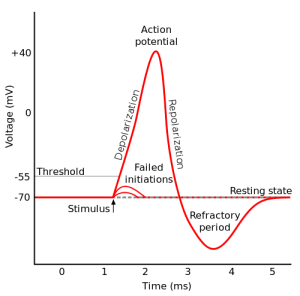
The membrane potential of a neuron is determined by the distribution of ions across the cell membrane.
At rest, the inside of a neuron is more negative than the outside due to the presence of negatively charged proteins and other molecules.
The movement of ions across the cell membrane can change the membrane potential.
For example, when sodium ions enter the cell, they make the inside of the cell more positive (less negative), causing depolarization.
Choice B is incorrect because -80 mV is below the typical threshold value for mammalian neurons.
Choice C is incorrect because +35 mV is above the typical threshold value for mammalian neurons.
Choice D is incorrect because 0 mV is above the typical threshold value for mammalian neurons.
Therefore, the Correct Answer is A.
More Questions on TEAS 7 Science
-
Q #1: Which of the following glands synthesizes antidiuretic hormone?
A. Pineal gland
B. Thymus
C. Hypothalamus
D. Pancreas
Answer Explanation
The hypothalamus is a region of the brain that synthesizes antidiuretic hormone (ADH), also known as vasopressin.
ADH is then transported to the posterior pituitary gland via neurohypophysial capillaries, where it is stored until it is ready to be secreted into the circulation.

Choice A.
Pineal gland is not correct because it is a small endocrine gland located in the brain that secretes the hormone melatonin, which regulates sleep-wake cycles, but it does not synthesize ADH.
Choice B.
Thymus is not correct because it is a gland located in the chest that produces hormones involved in immune system development, but it does not synthesize ADH.
Choice D.
Pancreas is not correct because it is a gland located behind the stomach that secretes hormones such as insulin and glucagon, which regulate blood sugar levels, but it does not synthesize ADH.
-
Q #2: Which of the following represents the complementary strand of a DNA sequence 3' TCGATCGCA 5'?
A. 3' AGCTAGCGT 5'
B. 5’ AGCTAGCGT 3’
C. 5' UCGAUCGCA 3'
D. 3' TCGUTCGCU 3'
Answer Explanation
In DNA, the nitrogenous bases adenine (A) and thymine (T) pair together, while cytosine (C) and guanine (G) pair together.
Therefore, the complementary strand of the given DNA sequence 3' TCGATCGCA 5' would have the complementary nitrogenous bases as:
5’ AGCTAGCGT 3’
NOTE: The 5’ to 3’ direction of the complementary strand is opposite to that of the given strand.
Choice A.
3’ AGCTAGCGT 5’ is not correct because it is not complementary to the given strand.
Choice C.
5’ UCGAUCGCA 3’ is not correct because it contains uracil (U), which is a nitrogenous base found in RNA, not DNA.
Choice D.
3’ TCGUTCGCU 3’ is not correct because it also contains uracil (U), which is a nitrogenous base found in RNA, not DNA.
-
Q #3: Which of the following structures is present in both prokaryotic and eukaryotic cells?
A. Cell membrane
B. Golgi apparatus
C. Chloroplasts
D. Endoplasmic reticulum
Answer Explanation
The cell membrane is present in both prokaryotic and eukaryotic cells.
The cell membrane is a thin, flexible barrier that surrounds all cells and separates the inside of the cell from the outside environment.
It is composed of a lipid bilayer and regulates the movement of substances into and out of the cell.

Choice B is incorrect because the Golgi apparatus is not present in prokaryotic cells.
The Golgi apparatus is an organelle found in eukaryotic cells that is involved in modifying, sorting, and packaging proteins and lipids for transport to other parts of the cell or to be secreted outside the cell.
Choice C is incorrect because chloroplasts are not present in prokaryotic cells.
Chloroplasts are organelles found in plant cells and some algae that are responsible for photosynthesis.
Choice D is incorrect because the endoplasmic reticulum is not present in prokaryotic cells.
The endoplasmic reticulum is an organelle found in eukaryotic cells that is involved in protein synthesis and lipid metabolism.
-
Q #4: Which of the following is the atomic number of an atom that has 12 protons and 12 neutrons?
A. 24
B. 12
C. 1
D. 144
Answer Explanation
The atomic number of an atom is equal to the number of protons in its nucleus.
In this case, the atom has 12 protons, so its atomic number is 12.
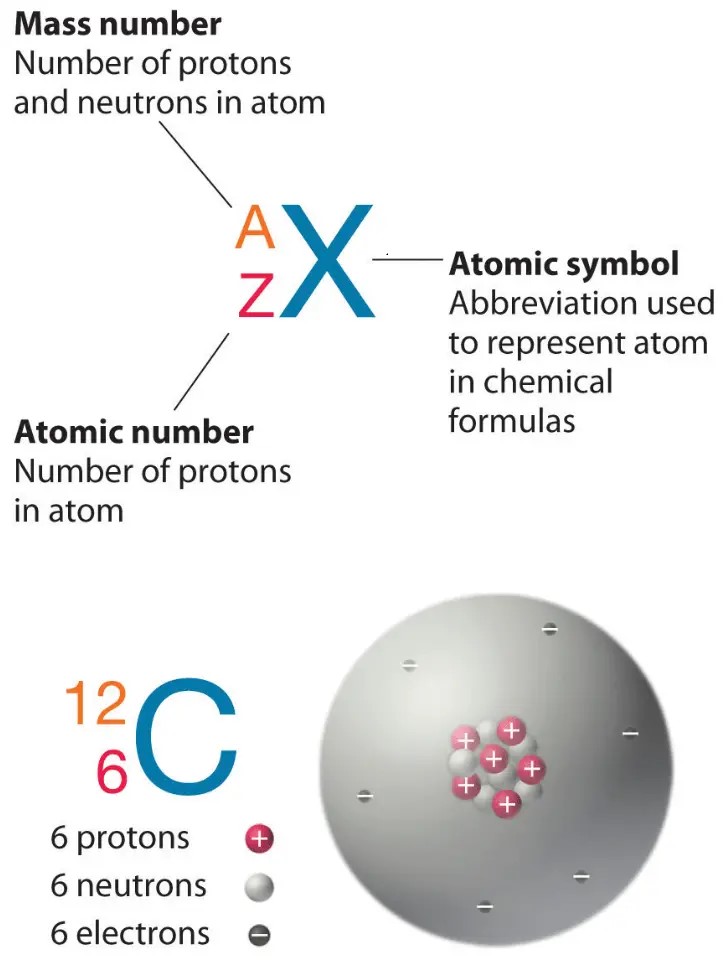
Choice A, 24, is not the correct answer because it represents the sum of the number of protons and neutrons in the atom’s nucleus, which is known as the mass number.
Choice C, 1, is not the correct answer because it does not represent the number of protons in the atom’s nucleus.
Choice D, 144, is not the correct answer because it represents the square of the mass number and does not represent any property of the atom.
-
Q #5: Which of the following physiological responses is caused by the release of antidiuretic hormone?
A. Increase in the concentration of calcium in the glomerulus.
B. Increase in water reabsorption in the collecting duct
C. Decrease in the concentration of calcium in the glomerulus.
D. Decrease in water reabsorption in the collecting duct
Answer Explanation
Antidiuretic hormone (ADH), also known as vasopressin, is a hormone that helps regulate the amount of water in your body.
It works to control the amount of water your kidneys reabsorb as they filter out waste from your blood.
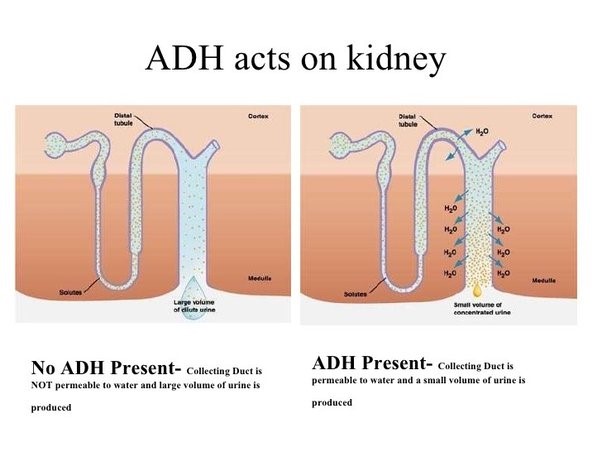
Choice A is not correct because an increase in the concentration of calcium in the glomerulus is not a physiological response caused by the release of antidiuretic hormone.
Choice C is not correct because a decrease in the concentration of calcium in the glomerulus is not a physiological response caused by the release of antidiuretic hormone.
Choice D is not correct because a decrease in water reabsorption in the collecting duct is not a physiological response caused by the release of antidiuretic hormone.
-
Q #6: Which of the following substances protects the skin from ultraviolet radiation?
A. Melanin
B. Perspiration
C. Sebum
D. Keratin
Answer Explanation
Melanin.
Melanin is a pigment produced by cells called melanocytes in the skin.
It protects the skin from ultraviolet (UV) radiation by absorbing and dissipating over 99.9% of absorbed UV radiation.
This helps to prevent DNA damage and other adverse effects of UV radiation on the skin.
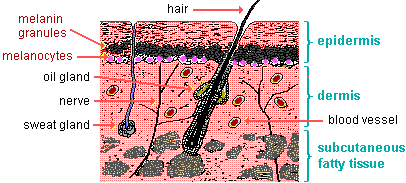
Choice B.
Perspiration is not correct because it is a fluid produced by sweat glands in the skin that helps to regulate body temperature, but it does not protect the skin from UV radiation.
Choice C.
Sebum is not correct because it is an oily substance produced by sebaceous glands in the skin that helps to lubricate and protect the skin, but it does not protect the skin from UV radiation.
Choice D.
Keratin is not correct because it is a fibrous protein that provides strength and durability to the skin, hair and nails, but it does not protect the skin from UV radiation.
-
Q #7: What is the approximate threshold value for mammalian neurons?
A. -55 mV
B. -80 mV
C. +35 mV
D. 0 mV
Answer Explanation
The approximate threshold value for mammalian neurons is -55 mV.
The threshold potential is the critical level to which a membrane potential must be depolarized to initiate an action potential.
Most often, the threshold potential is a membrane potential value between –50 and –55 mV

The membrane potential of a neuron is determined by the distribution of ions across the cell membrane.
At rest, the inside of a neuron is more negative than the outside due to the presence of negatively charged proteins and other molecules.
The movement of ions across the cell membrane can change the membrane potential.
For example, when sodium ions enter the cell, they make the inside of the cell more positive (less negative), causing depolarization.
Choice B is incorrect because -80 mV is below the typical threshold value for mammalian neurons.
Choice C is incorrect because +35 mV is above the typical threshold value for mammalian neurons.
Choice D is incorrect because 0 mV is above the typical threshold value for mammalian neurons.
-
Q #8: Which of the following microorganisms lack their own metabolic pathways and can only reproduce inside of a host cell?
A. Bacteria
B. Protozoa
C. Helminths
D. Viruses
Answer Explanation
Viruses.
Viruses lack essential machinery needed to reproduce by themselves.
In fact, viruses can only reproduce after infecting a living cell - a process called viral replication.
Once inside a living cell, viruses re-program the cell’s machinery to produce viral proteins and genetic material to make new copies of themselves.
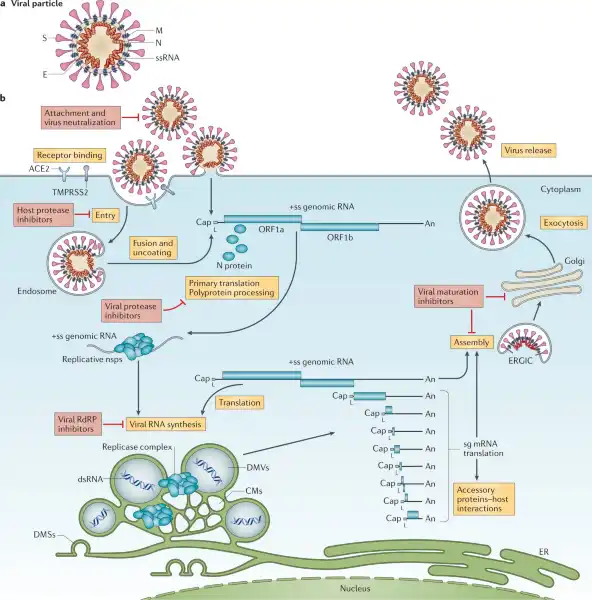
Choice A, Bacteria, is not the correct answer because bacteria have their own metabolic pathways and can reproduce outside of a host cell.
Choice B, Protozoa, is also not the correct answer because protozoa are singlecelled eukaryotes that have their own metabolic pathways and can reproduce outside of a host cell.
Choice C, Helminths, is not the correct answer because helminths are multicellular parasitic worms that have their own metabolic pathways and can reproduce outside of a host cell.
-
Q #9: Which of the following organic molecules contain both an amine and carboxyl group?
A. Lipids
B. Chitin
C. Cellulose
D. Proteins
Answer Explanation
Proteins.
Proteins are made up of amino acids which are organic molecules that contain both an amine functional group (–NH2) and a carboxylic acid functional group (– COOH).
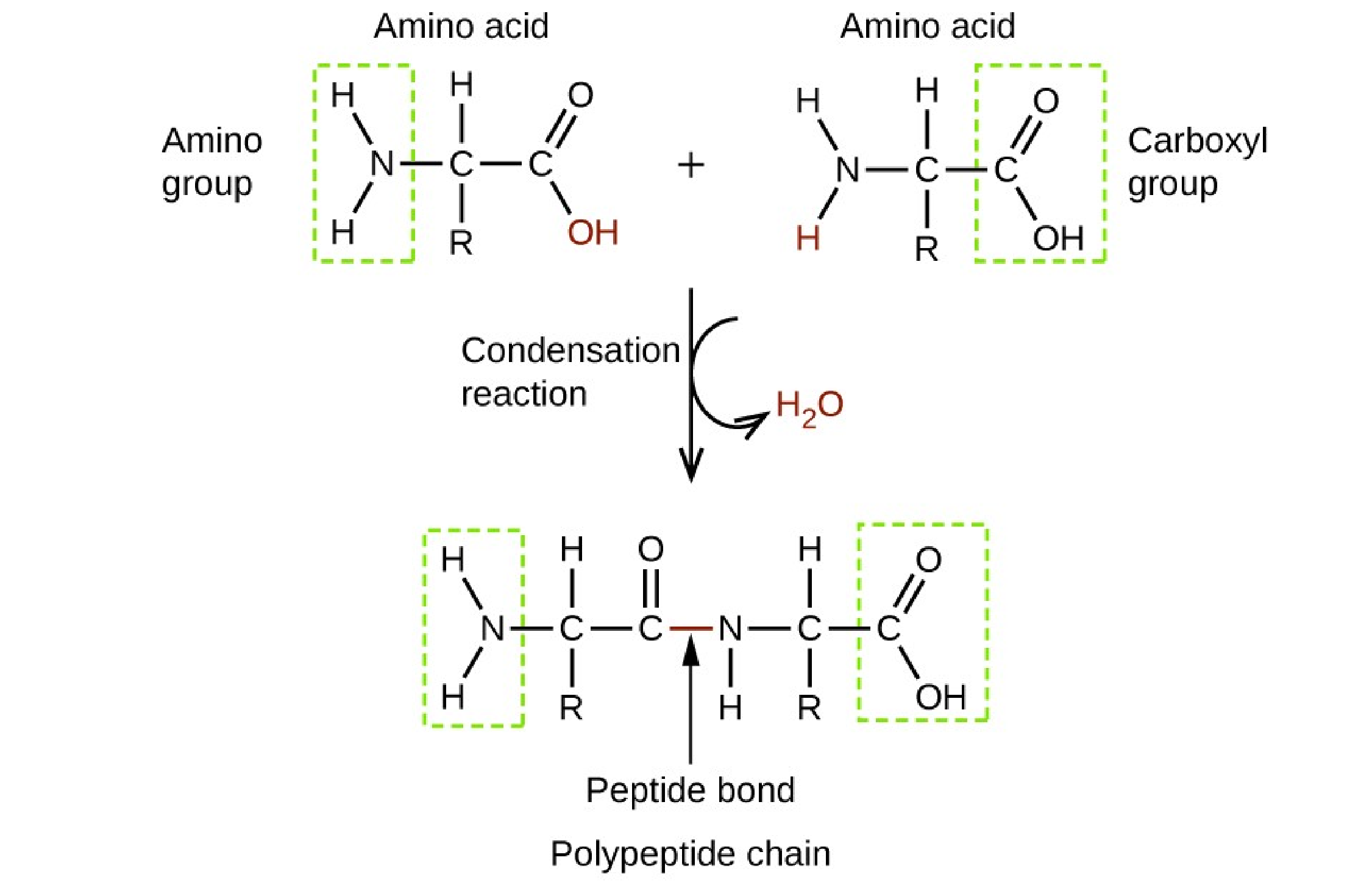
Choice A, Lipids, is not the correct answer because lipids are a group of naturally occurring molecules that include fats, waxes, sterols, fat-soluble vitamins, monoglycerides, diglycerides, triglycerides, phospholipids, and others.
They do not contain both an amine and carboxyl group.
Choice B, Chitin, is not the correct answer because chitin is a long-chain polymer of N-acetylglucosamine, a derivative of glucose.
It does not contain both an amine and carboxyl group.
Choice C, Cellulose, is not the correct answer because cellulose is an organic compound with the formula (C6H10O5)n, a polysaccharide consisting of a linear chain of several hundred to many thousands of β(1→4) linked D-glucose units.
It does not contain both an amine and carboxyl group.
-
Q #10: In a hypertonic solution, water flows through aquaporins embedded in the plasma membrane of the cell. This type of transport is best known as which of the following?
A. Facilitated diffusion
B. Active transport
C. Osmosis
D. Diffusion
Answer Explanation
Osmosis is the movement of water molecules across a selectively permeable membrane from an area of higher water concentration to an area of lower water concentration.
In a hypertonic solution, the concentration of solutes outside the cell is higher than inside the cell, so water flows out of the cell through aquaporins embedded in the plasma membrane to balance the concentration gradient.
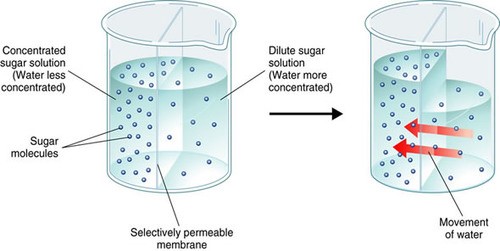
Choice A.
Facilitated diffusion is not correct because it is a type of passive transport that involves the movement of molecules across a membrane through specific transport proteins, but it does not specifically refer to the movement of water molecules.
Choice B.
Active transport is not correct because it is a type of transport that involves the movement of molecules against their concentration gradient and requires energy in the form of ATP, but osmosis is a passive process that does not require energy.
Choice D.
Diffusion is not correct because it refers to the movement of molecules from an area of higher concentration to an area of lower concentration, but it does not specifically refer to the movement of water molecules.
Free Access on TEAS 7 Exams and Study Notes
- Access to all TEAS 7 Exams
- Performance Tracking and Analysis
- Well Documented and Explained Questions and Answers
- 2000+ Questions and Correct Answers: Answers Well Explained
- Libary of Detailed StudyNotes
- Topical Questions and Answers on Examinable topics
TEAS 7 Exams (Q&A)
TEAS 7 Study Notes
TEAS 7 Topical Tests

TEAS 7 Study Guides
Quick Links
Refer a Friend
Refer a friend and claim free unlimited access

© 2024 ExamGates Made with by ExamGates
